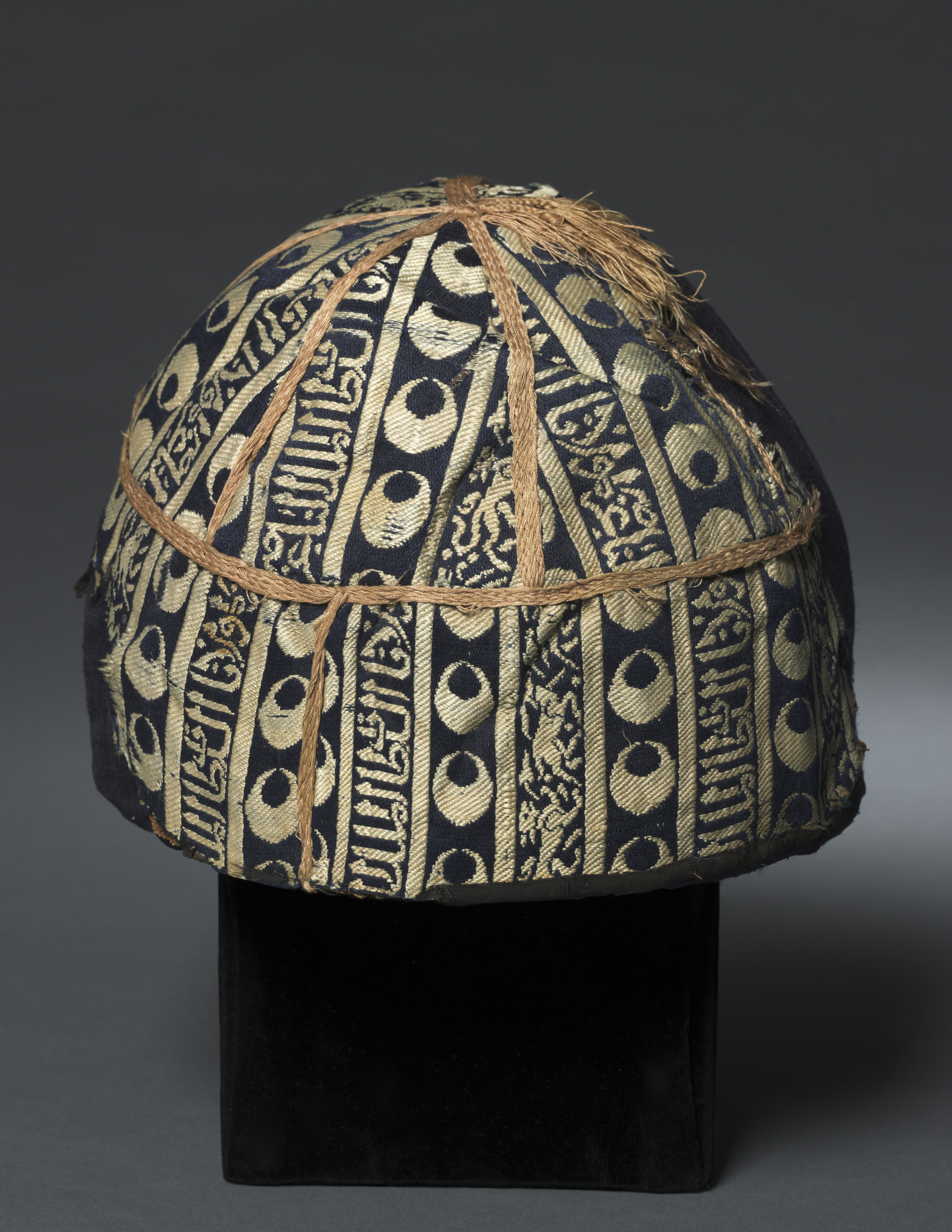The Cleveland Museum of Art
Collection Online as of April 25, 2024

Cap with striped inscribed silk
1300s
Overall: 11.4 x 16.5 x 16.5 cm (4 1/2 x 6 1/2 x 6 1/2 in.)
Location: 003 Special Exhibition Hall
Description
Headwear was a key part of men’s outfits in medieval Egypt. This luxurious cap was made using a complicated weaving technique, with alternating panels depicting prancing animals, crescent moons, and Arabic script that reads, “Glory to our lord Sultan al-Malik al-Nasir,” the Egyptian ruler. The pale pink trim might have once been a bold shade of red. Such products were created in highly regulated workshops in Cairo and reflect Egypt’s continued flourishing textile industry. Muslim dynasties such as the Mamluks (1250–1517) were known for the lavish garments worn at court and gifted among elites as preferred symbols of honor and praise.- by 1934–?Bacri Collection, Paris, France?–1985(Loewi - Robertson, Inc., Los Angeles, CA, sold to the Cleveland Museum of Art)1985–The Cleveland Museum of Art, Cleveland, OH
- Institut français d'archéologie orientale du Caire, Etienne Combe, Jean Sauvaget, and Gaston Wiet. Répertoire chronologique d'épigraphie arabe. Le Caire: Impr. de l'Institut français d'archéologie orientale, 1931. vol. 15, no. 5876Schmidt, J. Heinrich. “Damaste Der Mamlūkenzeit.” Ars Islamica 1, no. 1 (1934): 99–109. Reproduced: p. 108, fig. 12 www.jstor.orgCombe, Etienne, Jean Sauvaget, and Gaston Wiet. Répertoire chronologique d'épigraphie arabe. Vol. 15. Le Caire: Impr. de l'Institut français d'archéologie orientale, 1956. no. 5876Turner, Evan H. “The Year in Review for 1985.” The Bulletin of the Cleveland Museum of Art 73, no. 2 (1986): 26–71. Mentioned: no. 162, p. 69 www.jstor.orgWardwell, Anne E. "Flight of the Phoenix: Crosscurrents in Late Thirteenth- to Fourteenth-Century Silk Patterns and Motifs." The Bulletin of the Cleveland Museum of Art 74, no. 1 (1987): 2–35. Reproduced: pp. 20–21, fig. 26 www.jstor.orgWardwell, Anne E. “Flight of the Phoenix: Crosscurrents in Late Thirteenth- to Fourteenth-Century Silk Patterns and Motifs.” The Bulletin of the Cleveland Museum of Art 74, no. 1 (1987): 2–35. Mentioned and Reproduced: pp. 21–22, fig. 26 www.jstor.orgMackie, Louise W. Symbols of Power: Luxury Textiles from Islamic Lands, 7th-21st Century. Cleveland; New Haven: Cleveland Museum of Art; Yale University Press, 2015. Reproduced: P. 262, fig. 7.22; Mentioned: P. 263Soud, David. "Courting Beauty: How Artists, Patrons, and Intellectuals Fused Traditions and Created Distinctive Works Across the Islamic World." Humanities 37, no. 1 (January/February 2016): 12–16. Reproduced: p. 15Berzock, Kathleen Bickford. Caravans of Gold, Fragments in Time: Art, Culture, and Exchange Across Medieval Saharan Africa. Evanston, IL: Block Museum of Art, Northwestern University: in association with Princeton University Press, 2019.Mühlemann, Corinne. Complex Weaves: Technique, Text, and Cultural History of Striped Silks. Affalterbach: Didymos-Verlag, 2023. Mentioned: p. 14, fig. 4.1, p. 16, p. 85, p. 113-116, p. 119; Mentioned and reproduced: p. 198-199, no. 4, figs. 4.1-4.2
- Africa & Byzantium. The Cleveland Museum of Art, Cleveland, OH (co-organizer) (April 14-July 21, 2024).Caravans of Gold, Fragments in Time: Art, Culture, and Exchange across Medieval Saharan Africa. Mary and Leigh Block Museum of Art, Evanston, IL (organizer) (January 26-June 23, 2019).Luxuriance: Silks from Islamic Lands, 1250-1900. The Cleveland Museum of Art, Cleveland, OH (organizer) (May 14, 2013-June 23, 2014).Textiles from Egypt, Syria and Spain: 7th through 15th centuries. The Cleveland Museum of Art, Cleveland, OH (organizer) (November 26-June 6, 1991).
- {{cite web|title=Cap with striped inscribed silk|url=false|author=|year=1300s|access-date=25 April 2024|publisher=Cleveland Museum of Art}}
Source URL:
https://www.clevelandart.org/art/1985.5